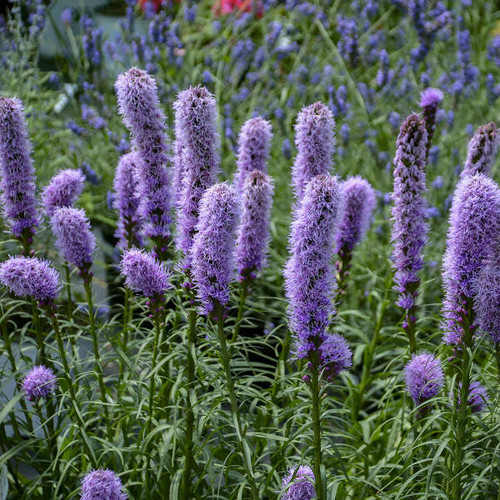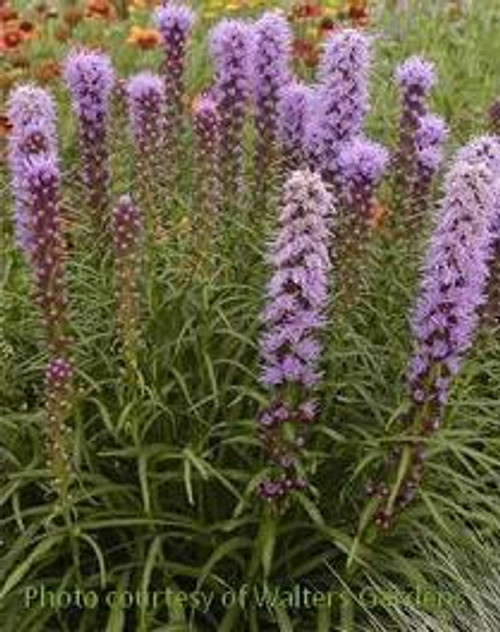Product Description
Liatris p. 'Lavender Glowsticks' (25) Bare Root Plants
Common Name: Prairie Blazing Star
Seed strain of the North American native perennial Liatris pycnostacha. This is a durable prairie plant, capable of thriving in tough clay soils and the heat of the summer. 'Lavender Glowsticks' was selected for exceptionally tall flower stalks - making up more than half of the plants total height - and long period of bloom. Flowers appear in the heat of the summer and are popular with pollinators and butterflies. A robust mound of dark foliage skirts the base of the plant.
Liatris thrive in well-drained soil in full sun. It is a suitable choice for southern gardens since it is very tolerant of hot summers. The roots of this genus are tuberous, and they may be lifted every few years and divided. When doing so, use a sharp knife, allow at least one eye per division, and dust the newly cut ends with a fungicidal powder before replanting.
Height: 4.0 Feet
Spread: 1.5-2.0 Feet
Hardiness Zones: 3,4,5,6,7,8,9
Flower Color: Purple shades
Foliage Color: Green shades
Full Sun (> 6 hrs. Direct Sun)
Average Water Needs
Poor to Fertile Soil Quality
Bloomtime: Early Summer - Midsummer
Attracts Butterflies
Bee Friendly
Deer Resistant
Seasonal Interest: Dried Seed Heads
Growth Rate: Medium
Border Plant, Cut Flower, Dried Flower, Mass Planting, Native to North America
Liatris pycnostachya 'Lavender Glowsticks' is a striking and statuesque perennial that adds vertical interest and vibrant color to sunny gardens. It is a cultivar of the North American native Liatris pycnostachya, commonly known as prairie blazing star or gayfeather, and it stands out for its exceptionally tall flower stalks and long blooming period. Here is a closer look at what makes it special, along with essential information for successful cultivation:
What Makes 'Lavender Glowsticks' Special:
- Tall Flower Stalks: The most distinctive feature of 'Lavender Glowsticks' is its exceptionally tall flower stalks, which can reach up to 2 feet in length and make up more than half of the plant's total height. These towering stalks create a dramatic vertical element in the garden.
- Abundant Lavender Flowers: The stalks are densely packed with vibrant lavender-purple flowers that bloom from the top down, creating a glowing effect that resembles a wand or "glowstick."
- Long Blooming Period: It blooms for an extended period in early to mid-summer, providing a long-lasting display of color.
- Attractive to Pollinators: The flowers are highly attractive to pollinators, including bees, butterflies, and hummingbirds, making it a valuable addition to any pollinator garden.
- Durable and Adaptable: It's a tough and adaptable plant that thrives in a variety of conditions, including clay soils and hot summers.
- Native Plant: As a cultivar of a native species, it is well-suited to naturalized areas and blends beautifully in native plant gardens.
Description:
- Type: Herbaceous perennial
- Hardiness Zones: 3-9
- Height & Spread: 4 feet tall and 1.5-2 feet wide
- Bloom Time: Early to mid-summer
- Flower Color: Lavender-purple
- Foliage: Robust mound of dark green foliage at the base
Native Habitat:
- Liatris pycnostachya is native to the central United States, where it typically grows in prairies, meadows, and open woods.
Landscaping Design Tips:
- Borders: Its vertical growth habit makes it a great addition to the middle or back of borders, adding height and visual interest.
- Meadow Gardens: It blends beautifully in meadow gardens, adding a touch of verticality and vibrant color.
- Naturalized Areas: Its adaptability to a variety of conditions makes it suitable for naturalizing in meadows or prairies.
- Cut Flower Gardens: The tall flower stalks make excellent cut flowers for arrangements.
- Rain Gardens: Its tolerance for clay soils and moist conditions makes it a good choice for rain gardens.
- Companion Planting: Combine it with other prairie plants, such as coneflowers (Echinacea), black-eyed Susans (Rudbeckia), or ornamental grasses.
Planting and Care:
- Planting:
- Plant in spring or fall.
- Choose a location with full sun.
- Prefers well-drained soil but tolerates clay.
- Space plants about 18-24 inches apart.
- Dig a hole slightly larger than the root ball.
- Place the plant in the hole, ensuring the crown is level with the ground.
- Fill the hole with soil and firm gently.
- Water thoroughly after planting.
- Care:
- Water regularly, especially during dry periods.
- Fertilize in spring with a balanced fertilizer.
- Deadhead spent flower spikes to encourage continuous blooming.
- Divide clumps every few years to maintain vigor.
With its tall, glowing flower stalks, vibrant color, and adaptability, Liatris pycnostachya 'Lavender Glowsticks' is a fantastic addition to any sunny garden. By following these planting and care tips, you can enjoy its beauty and attract pollinators to your yard for years to come.
Mature field grown roots shipped bare root.
Other Details
The most important part of the plant is its root system. Healthy roots are the foundation of a healthy, vibrant plant. The type of plug container used is based on the specific needs of the plants. Perennials offered as bare root traditionally perform better when planted as bare root.Planted in a specialized mix, potted plants have well established root systems. Top growth stage will vary depending on the current life cycle and time of year when shipped. In Winter and early Spring dormant plants may be shipped. Dormant plants may be planted right away, even before the last frost date.
Most bare root varieties are field grown for at least one season, though Hemerocallis and Hosta are grown for two seasons. The bulk of the soil is removed during the harvesting process and the tops of most varieties are trimmed back to the crown. They are graded, packed in shredded aspen or sphagnum moss and stored in freezers until ready to be shipped.
See our Container Sizes and Bare Root Perennials pages for more information.
Plant information and care is provided in the Overview section, Plant Genus Page and general information is provided in the Planting Care & Guides. Additional questions can be asked on each Plant page.
Plant Spacing: Using the maximum mature spread or width of a plant to guide spacing, ensures space to grow to full size. To fill an area sooner, plant them closer together. Just remember, future thinning or transplanting may be needed.
Water: Keep a close eye on newly planted perennials, especially throughout the first growing year. Most early plant loss is due to too much or too little water!










